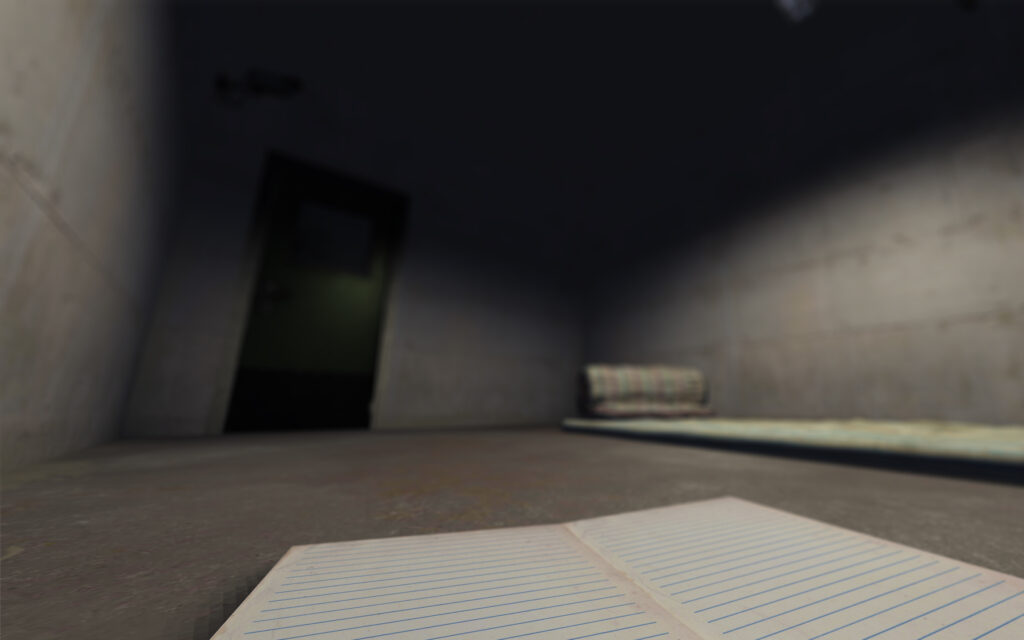Participatory WebVR Experiment, 2020

Installation view with participants wearing VR headsets.
Participatory WebVR Experiment
On an average day, do you spend more than 6 hours online, feeling bored, overwhelmed, and anxious at the same time? If so, you may be considered addicted to the Internet. According to Tao Ran(陶然), a Chinese psychologist and a leading expert in the field of Internet addiction, this situation may require mandatory treatments. These treatments could include restrictions on personal liberties and self-isolation to promote a better future.
Project Description
Virtual Confinement is an immersive web-based project that draws inspiration from the history of Internet addiction treatment in China and the effects of connectivity on social relationships. Set in a virtual isolation room, the project uses a WebVR environment to recreate Tao Ran’s adaptation of Morita therapy, a technique used in Chinese institutions in the 2000s to treat Internet addiction. Morita therapy is an ecological, purposive, response-oriented therapy integrated into treating Internet addiction as a metaphor for internalizing social issues, such as the gaming industry, as a vital national economic source.
The term “Internet addiction” was coined as a parody by American psychiatrist Ivan Goldberg in 1995, but soon gained traction in the medical community in the US and abroad. In the 2000s, the concept spread to East Asian countries, led by Chinese experts Tao Hongkai, Tao Ran, and Yang Yongxin. In 2008, China became the first country to classify Internet addiction as a clinical disorder.
Despite authoritative statements and the growing popularity of clinical terms, the medical profession has yet to define Internet addiction as a disease. In the past, numerous Chinese Internet addiction treatment facilities employed military-style training models, often subjecting juvenile and adult patients to abusive violence, which led to fatal cases. Over time, the history of treating Internet addiction in China has faded from people’s memories as the Internet and connected devices have become deeply embedded in our lives, serving as tools for domination and surveillance.
Set in a virtual isolation room with an interactive diary that opens when one directs their gaze at it, the project prompts participants to communicate exclusively through collective writing. Viewers can either switch their phones to VR mode and insert them into cardboard VR headsets for an enhanced experience or engage with the project directly on their screens to experience a moment of solitude on a mobile device with nowhere else to go.
Virtual Confinement creates an experience of solitude on the Web without requiring the audience to browse, echoing Sherry Turkle’s words: “We’re getting used to a new way of being alone together.” It examines the effects of connectivity on social relationships and the manifestation of reality as a cultural construct in the context of the pathologization of digital behavior as a ” trouble” of our own making.
計畫介紹
《虛擬禁閉》是一件沈浸式網路作品,靈感來自於中國網路成癮治療歷史以及連線能力對社會關係的影響。作品場景設置為一個虛擬隔離室,使用網頁VR環境重現2000年代中國網癮治療機構所使用的森田療法改編版本。森田療法是一種著重於環境、目標和反應的療法,在網路成癮治療中,這種療法被用來將更廣泛的社會問題(如遊戲產業成為國家重要經濟支柱等現象)內化為個人所面對的挑戰。
「網癮」一詞最早由美國精神病學家伊萬·戈德堡於1995年以戲謔方式提出,隨即在美國及國外醫學界受到關注。2000年代,由中國專家陶宏開、陶然和楊永信等人帶領,這一概念迅速傳播於東亞國家。2008年,中國成為第一個將網路成癮列為臨床疾病的國家。
儘管有了權威聲明和越來越多的臨床術語,醫學界尚未明確地將網路成癮定義為一種疾病。過去,中國許多網路成癮治療機構採用軍事化管理,經常對青少年和成年病患實施虐待及暴力,甚至有致死案例。然而,隨著時間推移,中國治療網路成癮的歷史逐漸從人們記憶中消失,因為網路和連網設備已成為我們生活中不可或缺的一部分,並被用作控制和監控的手段。
作品網頁所呈現的虛擬隔離房內有一本互動日記,只需將視線停留在其上日記本便會開啟,引導參與者透過集體書寫的方式進行交流。觀眾可選擇將手機切換至 VR 模式,配合紙盒頭盔來體驗虛擬實境,或是直接在螢幕上與作品互動,體驗行動裝置中無法逃脫的獨處時刻。
《虛擬禁閉》讓觀眾在不瀏覽網頁的情況下體驗網路中的獨處,呼應了雪莉‧特克(Sherry Turkle)的看法:「我們正在適應一種新的在一起孤獨的方式。」它探討了網路連接對人際關係的影響,以及在數位行為被病理化為自找「麻煩」的背景下,現實如何作為一種文化建構被呈現。
Click “Start” to view the demo of the WebVR environment on the Glitch platform.
Demo Webpage URL>>>https://virtual-confinement.glitch.me

Enter the WebVR environment with a personal mobile device.

Screenshots from the WebVR environment
Exhibitions
- 2023 Alone Together, Taipei Artist Village, Taipei, Taiwan
- 2021 Unbounded: Transmedia Storytelling, MIT, USA
- 2021 The Wonderful Creepiness, Jing Lü Art, Taipei, Taiwan
- 2021 Redirecting, Tree Museum, Beijing, China
- 2020 FLARE International New Media Art Festival, Shanghai, China


The virtual confinement room with an interactive diary.


The projection area is the same size as the virtual confinement room in the WebVR environment.
Credits
- Co-produced by Mengtai Zhang and Po-Hao Chi
- Interactive Programming: Lo Jo-Yu
